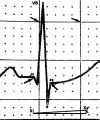The predictive value of exercise QRS duration changes for post-PTCA coronary events
- PMID: 12848815
- PMCID: PMC6932111
- DOI: 10.1046/j.1542-474x.2003.08110.x
The predictive value of exercise QRS duration changes for post-PTCA coronary events
Abstract
Background: The sensitivity and predictive values of exercise ECG testing using ST-T criteria after percutaneous transluminal coronary angioplasty (PTCA) are low, precluding its routine use for screening for restenosis. The predictive value of QRS duration criteria during exercise testing (ET) ECG after PTCA for future coronary events has not been reported. The aim of the study was to compare QRS duration changes with ST-T criteria during ET, as a predictor of coronary events after PTCA.
Methods: A prospective study of 206 consecutive patients who underwent ET at a mean of 34 +/- 14 days after their first PTCA, and were the followed for a mean of 23 +/- 9 months. Patients were divided by QRS duration into two groups-Q1: ischemic response (QRS duration prolongation of more than 3 ms relative to the resting duration), and Q2: normal response (QRS duration shortening or without change from resting duration). Patients were also divided by their ST-T response, S1: ischemic response, and S2: normal response.
Results: During follow-up 52 patients (58%) experienced restenosis or MI, or underwent CABG-Q1: 44 (85%), Q2: 8(15%) (P < 0.0002), S1: 8 (15%), S2: 44 (85%), (P < 0.641), two patients died-Q1: 1 (1%) and Q2: 1 (1%). For QRS and ST-T, the relative risk of having at least one of the coronary events was 4.02 (CI 2.1-9.9) versus 1.13 (CI 0.8-2.9), respectively. The sensitivity for future coronary events was 85% and 52% and the specificity was 48% and 98% for the QRS and ST-T criteria, respectively.
Conclusion: QRS prolongation during peak ET ECG after PTCA is a more sensitive marker than ST-T criteria for detection of patients at risk for later coronary events.
Figures






Similar articles
-
Use of QT dispersion measured on treadmill exercise electrocardiograms for detecting restenosis after percutaneous transluminal coronary angioplasty.Clin Cardiol. 1999 Oct;22(10):639-48. doi: 10.1002/clc.4960221010. Clin Cardiol. 1999. PMID: 10526688 Free PMC article.
-
Accuracy of treadmill exercise electrocardiography in detecting restenosis following single-vessel percutaneous transluminal coronary angioplasty.Am J Cardiol. 1997 Nov 15;80(10):1282-6. doi: 10.1016/s0002-9149(97)00666-8. Am J Cardiol. 1997. PMID: 9388099
-
Exercise-induced QRS prolongation in patients with mild coronary artery disease: computer analysis of the digitized multilead ECGs.J Electrocardiol. 1999;32 Suppl:206-11. doi: 10.1016/s0022-0736(99)90082-1. J Electrocardiol. 1999. PMID: 10688327
-
Role of exercise testing in relationship to coronary artery bypass surgery and percutaneous transluminal coronary angioplasty.Cardiology. 1986;73(4-5):242-58. doi: 10.1159/000174018. Cardiology. 1986. PMID: 2944582 Review.
-
Ambulatory electrocardiography evaluation of the post-coronary artery bypass graft and post-percutaneous transluminal coronary angioplasty patient. Diagnostic and prognostic value.Cardiol Clin. 1992 Aug;10(3):431-48. Cardiol Clin. 1992. PMID: 1504974 Review.
Cited by
-
Significance of QRS duration changes in the evaluation of ST-segment depression presenting exclusively during the postexercise recovery period.Ann Noninvasive Electrocardiol. 2006 Jul;11(3):241-6. doi: 10.1111/j.1542-474X.2006.00110.x. Ann Noninvasive Electrocardiol. 2006. PMID: 16846439 Free PMC article.
-
Brazilian Guideline for Exercise Test in the Adult Population - 2024.Arq Bras Cardiol. 2024 Feb;121(3):e20240110. doi: 10.36660/abc.20240110. Arq Bras Cardiol. 2024. PMID: 38896581 Free PMC article. English, Portuguese. No abstract available.
References
-
- Kligfield P, Okin PM. Evolution of the exercise electrocardiogram. Am J Cardiol 1994;73: 1209–1210. - PubMed
-
- Parrents E, Duard H, Couffinal T, et al The exercise‐recovery loop and exercise slope of ST‐segment changes/heart rate in the diagnosis of coronary disease and restenosis after angioplasty. Arch Mal Coeur Vaiss 1994;87: 1283–1288. - PubMed
-
- Cantor A, Goldfarb B, Aszodi A, et al. QRS prolongation measured by a new computerized method: A sensitive marker for detecting exercise‐induced ischemia. Cardiology 1997;88: 446–452. - PubMed
-
- Cantor A, Goldfarb B, Aszodi A, et al. Ischemia detection after myocardial infarction: Diagnostic value of exercise‐induced QRS duration changes evaluated by a new computerized method. J Electrocardiol 1998;31: 9–15. - PubMed
-
- Cantor A, Goldfarb B, Mai O, et al. Ischemia detection in women: The diagnostic value of exercise QRS duration changes. J Electrocardiol 1998;31: 271–277. - PubMed
Publication types
MeSH terms
LinkOut - more resources
Full Text Sources

